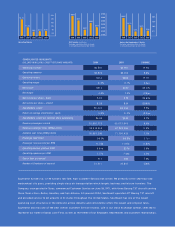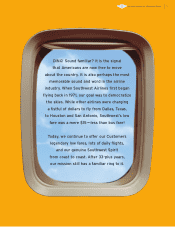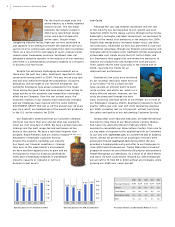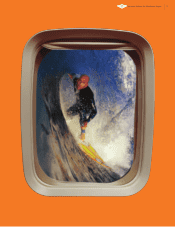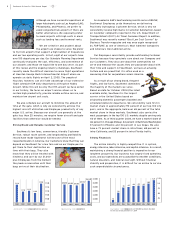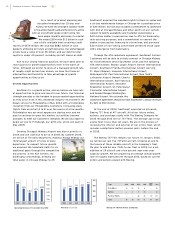Southwest Airlines 2004 Annual Report Download - page 7
Download and view the complete annual report
Please find page 7 of the 2004 Southwest Airlines annual report below. You can navigate through the pages in the report by either clicking on the pages listed below, or by using the keyword search tool below to find specific information within the annual report.
6Southwest Airlines Co. 2004 Annual Report
We continue to automate our airport
operations. All of our airports are
now equipped with RAPID CHECK-IN
self-service kiosks. Customers can
now print their boarding and transfer
passes when they check in either through
the self-service kiosks or through
southwest.com. While we have made great
strides in improving our productivity, controlling
and reducing our costs is an ongoing effort
that we will continue to pursue vigorously.
One of our greatest cost pressures is jet fuel, which is our
second highest cost category after labor. Although market jet
fuel prices were at record high levels during 2004, Southwest
had the wisdom and foresight to hedge approximately 80 to
85 percent of our fuel needs, which reduced our 2004 fuel
and oil expense by $455 million. We are well-protected in
2005 with 85 percent of our anticipated fuel needs hedged at
$26 per barrel of crude oil. We are also opportunistically
building hedging positions for future years and are currently
hedged 65percent at $32 per barrel in 2006; over 45 percent
at $31 per barrel in 2007; 30 percent at $33 per barrel in
2008; and over 25 percent at $35 per barrel in 2009.
In addition to our protective fuel hedging position, we have
implemented fuel conservation programs to offset high energy
costs. All of our Boeing 737-700 aircraft will have Blended
Winglets installed by March 2005, which are estimated to
produce around three percent annual savings on fuel consumption
per aircraft. Our Pilots, Dispatchers, Ground Operations, and
Fuel Management Employees also coordinate their efforts on
adaily basis to minimize fuel consumption as much as possible
and purchase fuel at the lowest costs.
Low Fares and Rapid Rewards
While the recent industry fare changes to lower and
simplified fares may be a new phenomenon for many airlines,
our Customers have always been able to rely on Southwest
Airlines for simple, low fares. From our inception, our
mission has been to giveAmericans the Freedom to Fly.
We have policed the skies for over 33 years with our
low-fare service and have made air travel
affordable for Americans. Unlike many of our
competitors, we never charge a rebooking or
exchange fee, nor have we ever required a
Saturday-night stay. After 33-plus years, our
low fares remain simple and reliable.
While there may be Southwest wannabes in
what appears to be a permanent low-fare
environment, the survivors will be the airlines
with the lowest costs, the highest quality service, and the best
Employees. Southwest Airlines has built its 32 years of profitable
operations on a low-fare, high quality, low-cost philosophy. We
have the best Employees in America, who are devoted to our
mission and Company. As a result, we remain well-positioned
with our proven business strategy to meet the challenges of
the airline industry with the ultimate objective of continued
prosperity, profitability, and job security for our deserving
Employees and increasing longterm value for our loyal
Employee and non-Employee Shareholders.
In addition to our low fares and convenient flight schedule,
our frequent flyers are generously rewarded with free trips
through our Rapid Rewards program. Rapid Rewards allows
Customers to receive a roundtrip Award valid for travel
anywhere Southwest flies by simply flying eight roundtrips or
earning 16 credits (a one-way ticket equals one credit) within
12 consecutive months. With no seat restrictions and limited
blackout dates, Members can use their Award to fly virtually
anytime to anywhere you can fly on Southwest. Rapid Rewards
Awards are also fully transferable. Inside Flyer magazine
recognized the generosity and simplicity of our Rapid Rewards
program in 2004 with awards for Best Customer Service, Best
Award Redemption, Best Web Site, and Best Bonus Promotion
among all frequent flyer programs. Rapid Rewards Members
can receive Rapid Rewards credits when doing business with
our Preferred Partners (Alamo,
®American Express,
®Budget,
®
Diners Club,
®Dollar,
®Hertz,
®Earthlink,
®Nextel,
®and Hilton,
®Hyatt,
®
Marriott,
®La Quinta,
®and Choice®brand hotels) as well as through
the use of the Southwest Airlines Rapid Rewards Visa credit card
issued by JPMorgan Chase Bank.
®
Proven Business Strategy
Southwest has a proven and
flexible business strategy. Even
though we offer low fares, our
strategy allows us to prosper in good
times and maintain profitability in bad times. Of course, the key
to our success is low costs, and our unique operating strategy
and Culture are the main ingredients to our low-cost formula.
Southwest has been able to continually achieve the highest
productivity of any major U.S. airline and, therefore, the
lowest unit costs (adjusted for stage length) in the U.S. airline
industry. Although many factors contribute to our historic
cost advantage, one of the primary drivers is our high asset
utilization resulting from our dedication to the low-fare,
point-to-point market niche. This market focus allows us to
operate a single aircraft type, the Boeing 737, which significantly
simplifies scheduling, operations, and maintenance, and
therefore minimizes costs.
We schedule our aircraft on a point-to-point, not hub-and-
spoke, basis and concentrate on the local, not through or
connecting, traffic. As a result, approximately 80 percent of
our Customers fly nonstop. Our point-to-point system, as
compared to hub-and-spoke, provides for more direct nonstop
routings for our Customers and, therefore, minimizes stops,
connections, delays, and total trip time. Although our frequent
flights and our recent codeshare agreement with ATA Airlines
at Chicago Midway allow for the convenient connection and
transfer of Customers, we schedule our aircraft based on local
traffic needs.
We serve many conveniently located secondary or downtown
airports such as Baltimore/Washington, Chicago Midway,
Dallas Love Field, Fort Lauderdale/Hollywood, Houston Hobby,
Long Island/Islip, Manchester, Oakland, and Providence.

